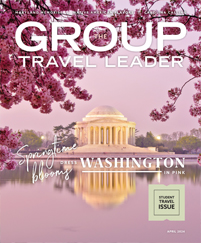Going South will soon be better than it has ever been.
Though many attractions and cultural institutions shuttered — at least temporarily — over the past two years, some used the downtime as an opportunity to expand and remodel. Other sites have recently opened their doors for the first time. Across the Southeast, popular destinations have added to their rosters of experiences, shining a spotlight on overlooked people and unsung heroes and giving visitors new ways to interpret our world.
Here are six new or updated attractions to include on your group’s next trek through the Southeast.
Africatown Heritage House and Welcome Center
Africatown, Alabama
In 1860, more than 50 years after the importation of enslaved people was made illegal, a schooner called the Clotilda smuggled 110 captives trafficked from West Africa to the shores of Mobile, Alabama. The vessel, which normally transported sugar and timber, was towed up the Mobile River in the middle of the night. The captives were hidden onshore, and the captors burned the boat. The top went up in smoke, but the bottom half, which was in the water, was discovered in 2018, casting an international spotlight on the story and its modern-day descendants.
“The story of the Clotilda is one that is just now coming to light for Alabama and the rest of America — and the world,” said Emily Eiland Gonzalez, vice president of marketing and communications at Visit Mobile. “It’s such an important story because it was the last ship to bring human cargo across trans-Atlantic slave trade routes.”
The captives were divided up amongst area plantations, where the majority of enslaved people were generational: They had been born in the United States and lived in slavery their whole lives. The recently arrived captives were assimilated only to be freed a few years later when the Civil War began. Many of the group then gathered and established their own town, called Africatown, north of downtown Mobile.
“The community and their descendants are still there today, with the graves, the first church, the schools built by Booker T. Washington; there’s history just dripping around every corner,” said Gonzalez. “In 2019, a journalist authenticated the remains of the Clotilda, and the story that everyone thought was folklore is being uncovered. It’s a story of hope and resilience.”
When it opens in the fall of 2022, groups will be able visit the Africatown Heritage House Museum, where multisensory exhibits uncover the lives of the individuals who were on the passage and their lives and families and the remains of the boat itself, plus reflect in a meditation garden.
Waterfront Botanical Gardens
Louisville, Kentucky
Louisville’s Waterfront Botanical Gardens broke ground in 2017 and took advantage of the pandemic shutdown to complete the Beargrass Creek Pathway, a walking and biking trail that connects the gardens to Butchertown, as well as a centrally located plaza fountain with a seasonally rotating horticultural display.
“We’ve developed 6 of the 23 acres of the designated space for the gardens; we’re starting our tree aisle of 24 American Dream Swamp white oak trees that will lead to an overlook for bird-watching that is a natural setting and wetlands,” said Lesley Kinney, the garden’s director of marketing and communications. “Our 2-acre Japanese Gardens were designed by Shiro Nakane and have all the things you’d expect in a traditional setting: large rocks, a waterfall and pond, arched bridges, a teahouse, cherry tree promenade and a bonsai garden.”
The Waterfront Botanical Gardens also has a rich history that’s worth noting. Once a neighborhood of 135 houses where French New Orleanians kept summer homes, the area suffered two devastating floods, in the 1930s and 1940s. After the first flood, the neighborhood became populated by Louisville’s working class, but after the second flood, the homes were unsalvageable. The city began using the area as a dump. The landfill was capped in the 1970s, starting a plan to stabilize the area to make it a green space. Today, the so-called gateway to the city has gone from landfill to landmark. A facade of one of the original homes, the Heigold House, stands as a monument to the past.
Groups are welcome to visit the gardens, where they can get docent-led tours, partake in special seasonal events or attend one of the wide range of classes on the roster ranging from fitness and cooking to herbology. Admission to the gardens is free.
National World War I Monument
Washington, D.C.
When the United States entered World War I in 1917, the country had no real military to speak of. Within months, 4.7 million Americans felt it was their obligation to register for the draft to serve their country. Over the span of only six months, more than 2 million went overseas and 116,516 paid the ultimate sacrifice.
Their bravery will soon be honored with a permanent memorial in Washington, D.C.: the National World War I Monument.
“It was the first time that people in our country joined a cause like this and left our shores to fight for the freedom and democracy of people they never met — they were willing to fight and die for basic humanity,” said Meredith Carr, deputy director of the World War I Centennial Commission. “It was largely forgotten and overshadowed by World War II, so I feel like we’re finally speaking for those who no longer have a voice to make sure they’re not forgotten. We’re not a country that will forget service and sacrifice.”
Designed by architect Joseph Weishaar, the memorial will feature a statue of Gen. John Pershing, commander of WWI Expeditionary Forces sent to fight on the Western Front, a stone Peace Fountain featuring a waterfall and pool with a poem by Archibald MacLeish, and exhibits about the role of the U.S. during the war. Pershing Park has been in use for decades but is being refreshed with the addition of the memorial.
“Taps is played every single day, rain or shine, at the memorial at 5 p.m. to honor those who served, but it sort of honors all veterans, everyone who came after, which is a wonderful way to visit the memorial,” said Carr. “It’s right off the National Mall, within walking distance of the Lincoln Memorial, the Washington Monument and the southeast gate of the White House.”
There’s a temporary canvas in the place of the last piece of the memorial, slated to be unveiled in 2024, a 12-foot-high, 60-foot-long bas-relief sculpture that hangs above the reflection pool. “A Soldier’s Journey” will feature 38 figures that tell a story of a reluctant soldier in progression to returning home a hero. For now, though, visitors can experience the memorial’s physical features as well as its interactive augmented reality app via the Doughboy Foundation or scan QR codes on artificial red poppies, which were a symbol of sacrifice during the war.
International African American Museum
Charleston, South Carolina
The role Charleston, South Carolina, played in the slave trade is well known, but a new museum in the city is set to create inspiration where there was once despair. Next year, the International African American Museum will open at Gadsden’s Wharf, the very place where boats loaded with human cargo used to dock. Twenty years in the making, the museum will sit on 18 13-foot pillars so the museum won’t touch the ground and is surrounded by the African Ancestors Memorial Gardens.
“One of the top things I’d recommend is touring the gardens,” said Tonya Matthews, CEO of the museum. “We’re right on the harbor, and there’s an infinity pool with an art installation at the bottom of the pool, so you’re looking at both an impressionistic reflection of the ocean and at the people who were brought across the ocean at the bottom of the infinity pool.”
The surrounding ethno-botanical gardens feature a curated selection of plants that share a common thread between Charleston and West Africa, and there is a sculptural element with kneeling and crouching figures surrounded by a reflective wall with the Maya Angelou quote “And still I rise.”
Matthews also recommends a visit to the Center of Family History, an active genealogical library where visitors can get help tracing their family tree and each of the eight galleries. But a particular favorite is the Gullah-Geechee gallery. It features examples of hand-carved canoes and a praise house, among other things.
“I think groups will really enjoy a visit to the Gullah-Geechee gallery, which celebrates the African Americans who have been here for 400 years on the sea islands in South Carolina,” Matthews said. “You can hear it in their accents, taste it in the food, see it in the celebration.”
There is also an interactive place-based table that will connect users to other African American heritage sites so groups can see other places to visit and other cultural information. There will be programming for people of all ages and special opportunities for charter members.
Turning Point Suffragist Memorial and the Lucy Burns Museum
Lorton, Virginia
It’s been just over 100 years since women in the U.S. won the right to vote, but few people know what a struggle the suffragist movement was. American suffragists spent more than 70 years in a bloodless revolution fighting for equality one step at a time. Now, those activists and their efforts are honored by the new Turning Point Suffragist Memorial, which is affiliated with the Lucy Burns Museum in Lorton, Virginia.
“The museum is located at the former site of the Lorton Prison, where suffragists were sent to the Occoquan Workhouse as part of their sentences, where there were hunger strikes and various things like that,” said Rebecca Super, director of the Lucy Burns Museum. “Part of the museum is about the suffrage story, and it includes the suffragists like Elizabeth Cady Stanton and Susan B. Anthony all the way through the passage of the 19th Amendment. But that’s not the end of the story, because that didn’t include women of color.”
Groups can visit the memorial, and just two blocks away is the Lucy Burns Museum. The museum is part of the Workhouse Arts Center, which features art exhibitions, classes and special events.
workhousearts.org/lucyburnsmuseum
National Museum of African American Music
Nashville, Tennessee
Dedicated to preserving African American music traditions and celebrating the influence African Americans have had on music, the National Museum of African American Music is a natural addition to Nashville. Right next door to Ryman Auditorium and the Nashville Music Garden, it’s a wonderful addition to the Rep. John Lewis Way (formerly 5th) and Broadway block.
“Music is an international language, and this museum is for anyone who wants to dig deeper into history,” said Tuwisha Rogers-Simpson, vice president of brand and partnerships for the museum. “Your bracelet will let you download things like playlists and other things to take home with you, like writing your own blues song.”
The museum’s interconnected galleries follow the history of African American music, beginning with “Rivers of Rhythm.” “Wade in the Water” traces the arrival of enslaved Africans in 1619 to the birth of gospel music; “Crossroads” explores the blues as the cornerstone of all American music; “A Love Supreme” digs into the Harlem Renaissance and the emergence of jazz; “One Nation Under a Groove” looks at the music of the civil rights movement; and “The Message” details the birth of hip-hop in New York City.
In each of the galleries, there is a combination of instruments, clothing and other paraphernalia on display, as well as the interactive displays that offer activities like recording your own song, videos and other ways to explore history.










